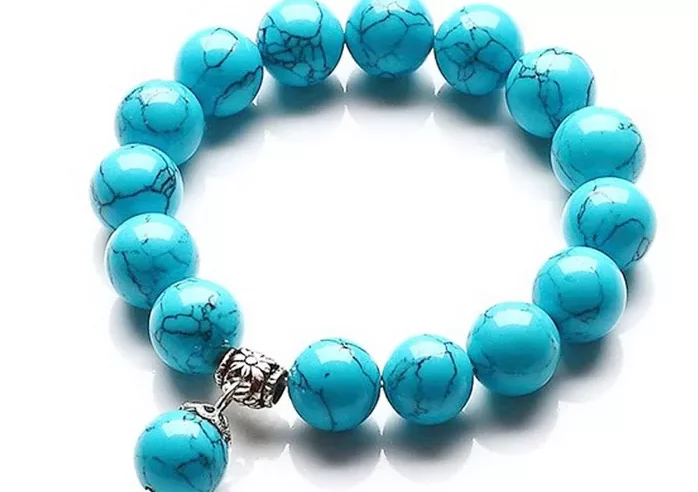Turquoise, with its mesmerizing hues reminiscent of the sky and sea, has captivated civilizations for millennia. From ancient Egypt to the Native American tribes of the Southwest United States, this gemstone has adorned kings and shamans alike. But where does this enchanting mineral primarily reside in the world? Join us on a journey to uncover the geographic hotspots of turquoise, exploring the geological formations and cultural significance that make each location unique.
The Origins of Turquoise
To understand the distribution of turquoise, one must first delve into its geological origins. Turquoise typically forms through the interaction of copper-rich fluids with porous rocks such as limestone or volcanic rocks. These fluids percolate through the earth’s crust, depositing copper compounds along with aluminum and phosphorus in cracks and voids.
Over time, these deposits undergo a process of alteration and dehydration, transforming into the vibrant blue-green mineral known as turquoise. The presence of other minerals and elements, such as iron and zinc, can influence the color and quality of the turquoise.
See Also: The Origins & Properties of Turquoise
Southwestern United States: The Land of Turquoise
One of the most iconic regions associated with turquoise is the Southwestern United States, particularly the states of Arizona, New Mexico, and Nevada. Here, turquoise deposits are intimately intertwined with the rich cultural heritage of Native American tribes such as the Navajo, Hopi, and Zuni.
Arizona stands out as a premier source of turquoise, with renowned mines like the Sleeping Beauty Mine and the Kingman Mine producing high-quality specimens prized by collectors and jewelry artisans worldwide. New Mexico boasts its own turquoise hotspots, including the famous Cerrillos and Tyrone mines, where turquoise has been mined for centuries.
Egypt: Ancient Treasures Beneath the Sands
In the ancient world, turquoise held profound significance, particularly in civilizations such as ancient Egypt. The Egyptians mined turquoise extensively in the Sinai Peninsula, where deposits were found in conjunction with copper ores. The vibrant blue-green stone was highly prized for jewelry, amulets, and ceremonial artifacts, symbolizing protection, fertility, and divine connection.
Archaeological excavations have uncovered turquoise artifacts dating back thousands of years, providing insight into the cultural and economic importance of this gemstone in ancient Egyptian society. While modern mining operations in the Sinai Peninsula are limited, the legacy of Egyptian turquoise continues to captivate historians and gem enthusiasts alike.
Iran: Turquoise of the Persians
Iran, historically known as Persia, boasts a rich tradition of turquoise mining and craftsmanship dating back centuries. The country’s Nishapur region, located in northeastern Iran, is renowned for its turquoise deposits, which have been mined since antiquity.
Persian turquoise is esteemed for its vivid blue color and fine spiderweb or matrix patterns, making it highly sought after for ornamental purposes. Iranian artisans are renowned for their intricate turquoise jewelry and decorative objects, showcasing the skillful craftsmanship that has been passed down through generations.
China: Treasures of the Silk Road
Along the ancient Silk Road, turquoise served as a valuable commodity traded between East and West. China, with its vast and diverse landscape, is home to several turquoise deposits, notably in the Xinjiang Uygur Autonomous Region in the northwest.
The Chinese have a long history of mining and using turquoise for jewelry, religious artifacts, and decorative items. Turquoise from China often exhibits unique characteristics, including varying shades of blue and green, as well as distinctive matrix patterns influenced by the surrounding geological formations.
Mexico: From Aztec Treasure to Modern Marvel
Mexico boasts a rich heritage of turquoise mining, with deposits found in regions such as Sonora, Chihuahua, and Zacatecas. The country’s turquoise mining tradition dates back to pre-Columbian times when civilizations like the Aztecs prized the gemstone for its beauty and perceived spiritual qualities.
Today, Mexican turquoise continues to be revered for its vibrant colors and diverse matrix patterns, ranging from intricate spiderweb designs to bold veining. Mines such as the famous Campitos and Cananea produce turquoise of exceptional quality, coveted by jewelry designers and collectors worldwide.
Other Notable Sources: Exploring Turquoise Diversity
Beyond the aforementioned regions, turquoise can be found in various other parts of the world, each offering its own unique characteristics and cultural significance:
Afghanistan: The mines of the Hindu Kush mountains yield turquoise prized for its intense blue color and fine matrix patterns.
Tibet: Turquoise holds deep cultural and religious significance in Tibetan Buddhism, with deposits found in regions such as the Himalayas.
Australia: The land down under is home to turquoise deposits in Western Australia, where the stone is valued for its striking colors and unique matrix formations.
Challenges and Conservation Efforts
Despite its enduring allure, turquoise faces threats from overmining, environmental degradation, and illegal trade. In regions where mining operations are poorly regulated, ecosystems and local communities may suffer the consequences of unchecked exploitation.
Conservation efforts aimed at sustainable mining practices, habitat restoration, and cultural preservation are crucial for safeguarding the future of turquoise. Collaborative initiatives involving government agencies, indigenous communities, and conservation organizations play a vital role in promoting responsible stewardship of turquoise resources worldwide.
Conclusion
Turquoise, with its timeless beauty and cultural significance, weaves a rich tapestry that spans continents and civilizations. From the sun-baked deserts of the American Southwest to the rugged mountains of Central Asia, the allure of turquoise endures as a symbol of beauty, spirituality, and connection to the earth.
As we explore the diverse landscapes and cultural traditions associated with turquoise, let us not only marvel at its aesthetic splendor but also recognize the importance of preserving its legacy for future generations. By embracing sustainable practices and fostering appreciation for this precious gemstone, we can ensure that turquoise continues to inspire and enchant for centuries to come.


